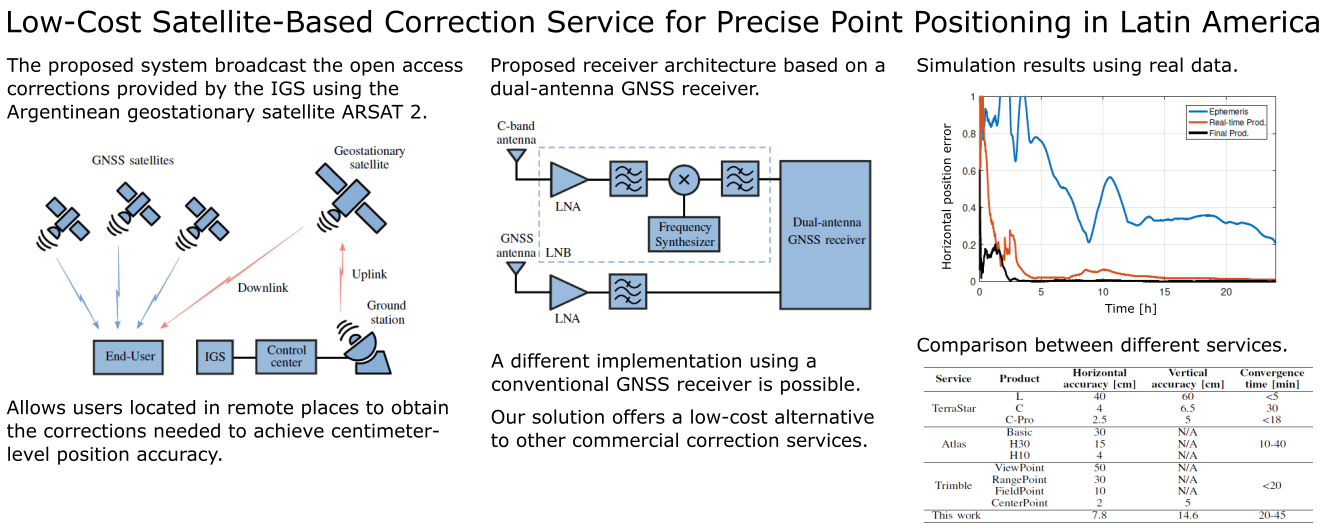Low-Cost Satellite-Based Correction Service for Precise Point Positioning in Latin America
Keywords:
Satellite navigation systems, precise positioning, correction service, satellite broadcastingAbstract
Global Navigation Satellite Systems (GNSS) applications have been continuously expanding during the last years. When centimeter-level accuracy is required, the use of a single conventional GNSS receiver is not suitable because of the presence of different error sources that degrade the quality of its measurements. Precise Point Positioning (PPP) methods depend on applying corrections to significantly improve the accuracy of a single receiver allowing to obtain centimeter-level performance. This paper focuses on the design of a satellite-based service that broadcast the open access corrections for PPP generated by the International GNSS Service (IGS) being appropriate for real-time applications. The proposed system is based on the Argentinian geostationary satellite ARSAT 2 capable of providing service to Latin America. The system requirements and specifications are defined in order to deliver a good quality of service reducing the complexity and the cost of the users’ receivers. Thoroughly analyzes and calculations carried out demonstrate that, adopting practical design criteria, a low-cost implementation is possible. We present the main characteristics of the uplink ground station and downlink user receivers. Moreover, different user receiver architectures as well as the design of a simple antenna are proposed. Simulation results using real data show that our solution is able to provide up to centimeter-level accuracy achieving a performance similar to other costly commercial correction services.
Downloads
References
C. Hegarty, E. Kaplan, M. Uijt de Haag, and R. Cosentino, “GNSS errors,” in Understanding GPS/GNSS: Principles and Applications
(E. Kaplan and C. Hegarty, eds.), ch. 10, pp. 619–658, Norwood, MA: Artech House, 3 ed., 2017.
J. Sanz Subirana, J. Juan Zornoza, and M. Hernández-Pajares, GNSS Data Processing, vol. 1. Noordwijk, Netherlands: ESA Communications, 2013.
N. Zhu, J. Marais, D. Bétaille, and M. Berbineau, “GNSS position integrity in urban environments: A review of literature,” IEEE Trans.
Intell. Transp. Syst, vol. 19, no. 9, pp. 2762–2778, 2018.
European Global Navigation Agency, “GSA GNSS Market Report,” 2019.
S. Bisnath, M. Uijt de Haag, D. Diggle, C. Hegarty, D. Milbert, and T. Walter, “Differential GNSS and precise point positioning,” in
Understanding GPS/GNSS: Principles and Applications (E. Kaplan and C. Hegarty, eds.), ch. 10, pp. 709–784, Norwood, MA: Artech House,
ed., 2017.
D. Odijk and L. Wanninger, “Differntial positioning,” in Springer Handbook of Global Navigation Satellite Systems (P. Teunissen and O. Montenbruck, eds.), ch. 10, pp. 753–780, Cham, Switzerland: Springer, 2017.
J. Zumberge, M. Heflin, D. Jefferson, M. Watkins, and F. Webb, “Precise point positioning for the efficient and robust analysis of GPS data from large networks,” Journal of Geophysical Research, vol. 102, no. B3, pp. 5005–5017, 1997.
C. Rizos, V. Janssen, C. Roberts, and T. Grinter, “Precise point positioning: Is the era of differential GNSS positioning drawing to an end?,” in FIG Working Week 2012, May 2012.
J. Kouba and P. Héroux, “Precise point positioning using IGS orbit and clock products,” GPS Solutions, vol. 102, pp. 12–28, 2001.
M. López, S. Rodríguez, J. García, and C. Muravchik, “Performance comparison of precise point positioning using real-time oriented GNSS products,” in 2019 Argentine Conference on Electronics (CAE 2019), pp. 52–57, March 2019.
P. Li and X. Zhang, “Integrating GPS and GLONASS to accelerate convergence and initialization times of precise point positioning,” GPS Solutions, vol. 18, pp. 461–471, 2014.
D. Laurichesse and A. Blot, “Fast PPP convergence using multiconstellation and triple frequency ambiguity resolution,” in 29th Int.
Tech. Meeting Satell. Div. Inst. Navig. (ION GNSS+ 2016), pp. 2082–2088, Sept. 2016.
Hemisphere, “Atlas® GNSS Global Correction Service,” 2020.
NovAtel, “TerraStar® Global Correction Services: Global Correction Services,” 2019.
C. Wang and R. Hatch, “StarFire® GNSS: The Next Generation StarFire Global Satellite Based Augmentation System,” 2012.
Trimble, “OmniSTAR® Services that Covers the Earth,” 2012.
Z. Nie, F. Liu, and Y. Gao, “Real-time precise point positioning with a low-cost dual-frequency GNSS device,” GPS Solutions, vol. 24, no. 9, pp. 1–11, 2019.
L. Wang, Z. Li, N. Wang, and Z. Wang, “Real-time GNSS precise point positioning for low-cost smart devices,” GPS Solutions, vol. 25, no. 69, pp. 1–13, 2021.
P. Zhou, Low-Cost Real-Time Precise Point Positioning (PPP) Correction Service with High Availability and Accuracy. PhD thesis, University of Calgary, 2020.
International GNSS Service, “IGS Real-Time Service,” 2013.
ARSAT, “ARSAT 2 Prestaciones Generales,” 2019. rev. 1.
C. Balanis, Antenna Theory: Analysis and Design. Hoboken, NJ: John Wiley & Sons, 4 ed., 2016.
S. Haykin, Digital Communication Systems. Hoboken, NJ: John Wiley & Sons, 2013.
Global Positioning Systems Directorate, “IS-GPS-200 NAVSTAR GPS Space Segment/Navigation User Segment Interfaces,” 2019.
T. Nguyen and C. Wang, “On the link budget calculation for cdma systems,” in 2001 IEEE Aerospace Conference Proceedings Proceedings, pp. 2/909–2/913, March 2001.
R. Gagliardi, Satellite Communications. New York, NY: Van Nostrand Reinhold, 2 ed., 1991.
R. Freeman, Radio System Design for Telecommunications. Hoboken, NJ: John Wiley & Sons, 3 ed., 2007.
Skyworks Solutions Inc., “SKY67183-396LF: 400 to 6000 MHz Broadband Low-Noise Amplifier,” 2020.
“BGB707L7ESD General Purpose LNA MMIC with Integrated ESD Protection and Active Biasing,” 2018.
S. Rodríguez, J. García, G. Scillone, J. Díaz, M. López, and R. López La Valle, “Dual-antenna dual-band high performance cubesat-compatibleGPS receiver,” IEEE Latin America Transactions, vol. 18, no. 2, pp. 265–272, 2020.
P. Bhartia, I. Bahl, R. Garg, and A. Ittipiboon, Microstrip Antenna Design Handbook. Norwood, MA: Artech House, 2001.
Rogers Corporation, “RO4000® Series High Frequency Circuit Materials,” 2018.
J.Wang, “Antennas for global navigation satellite system (GNSS),” Proc. IEEE, vol. 100, no. 7, pp. 2349–2355, 2012.
Nasimuddin, X. Qing, and Z. N. Chen, “A compact circularly polarized slotted patch antenna for GNSS applications,” IEEE Trans. Antennas Propag., vol. 62, no. 12, pp. 6506–6509, 2014.
Crustal Dynamics Data Information System, “International GNSS service, daily 30-second observation data.” Available:
http://cddis.gsfc.nasa.gov/Data_and_Derived_Products/GNSS/daily_gnss_o.html, Oct. 2020.
International GNSS Service, “IGS products.” Available: https://kb.igs.org/hc/en-us/articles/115003935351, Oct. 2020.
NovAtel, “TerraStar correction services.” Available: https://novatel.com/products/gps-gnss-correction-services/terrastar-correction-services/compare, March 2022.
Hemisphere, “Atlas® GNSS global correction service.” Available: https://www.hemispheregnss.com/product/atlas-gnss-global-correction-service, March 2022.
Trimble, “RTX correction service.” Available: https://help.trimblegeospatial.com/TrimbleAccess/latest/en/GNSS-survey-RTX.htm,
March 2022.
Trimble, “Accuracy chart.” Available: https://positioningservices.trimble.com/wp-content/uploads/2019/02/accuracy_chart.pdf,
March 2022.


